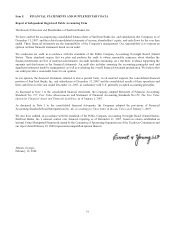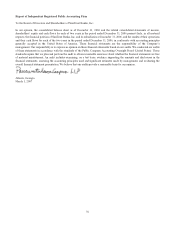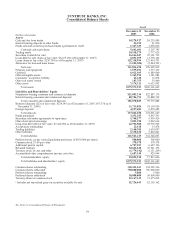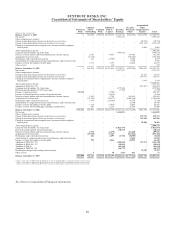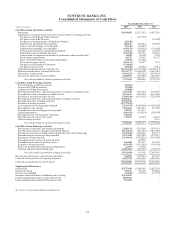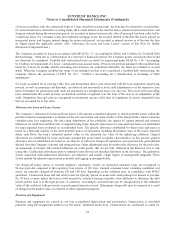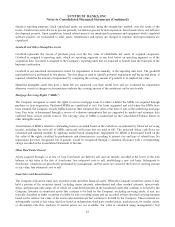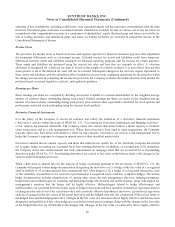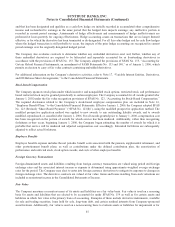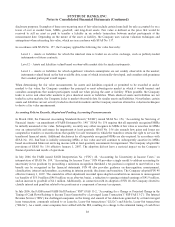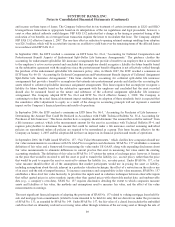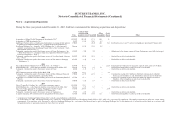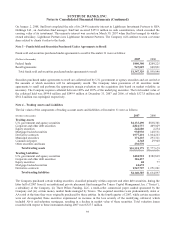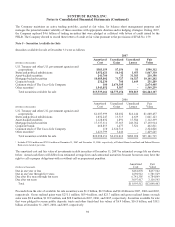SunTrust 2007 Annual Report Download - page 96
Download and view the complete annual report
Please find page 96 of the 2007 SunTrust annual report below. You can navigate through the pages in the report by either clicking on the pages listed below, or by using the keyword search tool below to find specific information within the annual report.SUNTRUST BANKS, INC.
Notes to Consolidated Financial Statements (Continued)
a loan in accordance with the contractual terms of a loan classified as nonaccrual, the loan may be returned to accrual status.
If a nonaccrual loan is returned to accruing status, the accrued interest at the date the loan is placed on nonaccrual status, and
foregone interest during the nonaccrual period, are recorded as interest income only after all principal has been collected for
commercial loans. For consumer loans and residential mortgage loans, the accrued interest at the date the loan is placed on
nonaccrual status, and forgone interest during the nonaccrual period, are recorded as interest income as of the date the loan
no longer meets the applicable criteria. (See “Allowance for Loan and Lease Losses” section of this Note for further
discussion of impaired loans.)
The Company accounts for loans in accordance with SFAS No. 15 “Accounting by Debtor and Creditors for Troubled Debt
Restructurings,” when due to a deterioration in a borrower’s financial position, the Company grants concessions that would
not otherwise be considered. Troubled debt restructured loans are tested for impairment under SFAS No. 114, “Accounting
by Creditors for Impairment of a Loan,” and placed in non-accrual status. If borrowers perform pursuant to the modified loan
terms for at least six months and the remaining loan balances are considered collectible, the loans are returned to accrual
status. When the Company modifies the terms of an existing loan that is not considered a troubled debt restructuring, the
Company follows the provisions of EITF No. 01-7, “Creditor’s Accounting for a Modification or Exchange of Debt
Instruments.”
For loans accounted for at carrying value, fees and incremental direct costs associated with the loan origination and pricing
process, as well as premiums and discounts, are deferred and amortized as level yield adjustments over the respective loan
terms. Premiums for purchased credit cards are amortized on a straight-line basis over one year. Fees received for providing
loan commitments that result in loans are deferred and then recognized over the term of the loan as an adjustment of the
yield. Origination fees and costs are recognized in noninterest income at the time of origination for newly originated loans
that are accounted for at fair value.
Allowance for Loan and Lease Losses
The Company’s allowance for loan and lease losses is the amount considered adequate to absorb probable losses within the
portfolio based on management’s evaluation of the size and current risk characteristics of the loan portfolio. Such evaluation
considers prior loss experience, the risk rating distribution of the portfolios, the impact of current internal and external
influences on credit loss and the levels of nonperforming loans. Specific allowances for loan and lease losses are established
for large impaired loans evaluated on an individual basis. The specific allowance established for these loans and leases is
based on a thorough analysis of the most probable source of repayment, including the present value of the loan’s expected
future cash flows, the loan’s estimated market value, or the estimated fair value of the underlying collateral. General
allowances are established for loans and leases grouped into pools based on similar characteristics. In this process, general
allowance factors established are based on an analysis of historical charge-off experience and expected loss given default
derived from the Company’s internal risk rating process. Other adjustments may be made to the allowance for the pools after
an assessment of internal and external influences on credit quality that are not fully reflected in the historical loss or risk
rating data. Unallocated allowances relate to inherent losses that are not included elsewhere in the allowance. The qualitative
factors associated with unallocated allowances are subjective and require a high degree of management judgment. These
factors include the inherent imprecisions in models and lagging or incomplete data.
Our charge-off policy meets or exceeds regulatory minimums. Losses on unsecured consumer loans are recognized at
90-days past-due compared to the regulatory loss criteria of 120 days. Secured consumer loans, including residential real
estate, are typically charged-off between 120 and 180 days, depending on the collateral type, in compliance with FFIEC
guidelines. Commercial loans and real estate loans are typically placed on nonaccrual when principal or interest is past-due
for 90 days or more unless the loan is both secured by collateral having realizable value sufficient to discharge the debt
in-full and the loan is in the legal process of collection. Accordingly, secured loans may be charged-down to the estimated
value of the collateral with previously accrued unpaid interest reversed. Subsequent charge-offs may be required as a result
of changes in the market value of collateral or other repayment prospects.
Premises and Equipment
Premises and equipment are carried at cost less accumulated depreciation and amortization. Depreciation is calculated
primarily using the straight-line method over the assets’ estimated useful lives. Certain leases are capitalized as assets for
84



